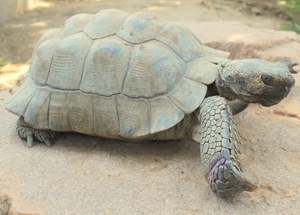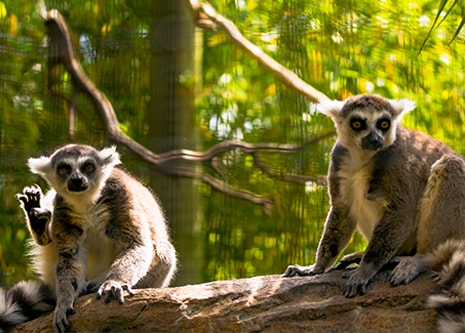
- VisitSupport Happy HollowDONATE TODAYExploreSupport Happy HollowDONATE TODAYLearnSupport Happy HollowDONATE TODAYSupport
-
Today's Hours: 10:00 am to 4:00 pm
Zoo in the HollowAfrican spurred tortoise

Scientific name: Centrochelys sulcata
Family: Testudinidae
Order: Testudines
Class: Reptilia
Range: Sub-Sahara Desert in Africa
Habitat: Grassland, Shrubland
Lifespan: 30 to 50 years on average; possibly up to 80 yearsWhat do they look like?
Male African spurred tortoises can grow to be over 30 inches long, with females typically reaching a length of 20 inches. Males typically weigh 125 to 150 pounds. The smaller females typically weigh about half as much as their male counterparts. African spurred tortoises have broad carapaces (top shell) and plastrons (bottom shell) that are brown to tan. Tortoise shells show growth rings within each scute (shell plate) similar to trees, although the rings on tortoises do not accurately indicate age. They have thick skin and scales covering their limbs that help reduce water loss. African spurred tortoises get their name from the spurs on their hind legs.
How do they behave?
These tortoises live in arid regions which do not get much rainfall. They spend the hottest parts of the day in burrows underground to keep cool. These burrows are usually dug 2 to 3 feet under the surface, but can extend over 10 feet. As ectotherms (animals that cannot generate their own body heat), African spurred tortoises rely on ambient temperatures for heat. African spurred tortoises become inactive if the weather is too hot or too cold, and are most active at dawn and dusk.
What’s do they eat?
African spurred tortoises, like all tortoises, are herbivores. They spend a large portion of the day grazing and require diets high in fiber. In the wild, they eat grasses, flowers and weeds. At Happy Hollow, they are fed grass hay and vegetables.
How are they born?
Males become very vocal during mating season and will actively fight with other males for breeding rights. Females usually dig several nests before choosing which to lay their eggs in. Clutches consist of 10 to 30 eggs. In the wild, eggs can incubate for up to eight months. In captivity, eggs can hatch anywhere between 90 to 180 days, though the average is 100 to 120 days. Hatchlings are about 2 inches long and are yellow in color, with each scute being heavily outlined in dark brown.
What should you know about them?
African spurred tortoises are the world’s largest mainland tortoise. They are only surpassed in size by the Aldabra giant tortoise of the Aldabra Atoll north of Madagascar, and the Galapagos tortoise, of the Galapagos Islands.
Conservation
The African spurred tortoise is listed as a vulnerable species by the International Union for Conservation of Nature. Several organizations are dedicated to the protection of African spurred tortoises; including the Fondation Rurale pour le Développement, a nongovernmental organization that focuses on habitat preservation and population monitoring in Senegal. One of the biggest threats to the African spurred tortoise is the pet trade. African spurred tortoises are often sold in the pet trade under the name “sulcata tortoise.” Due to their large adult size, habitat requirements and conservation status, African spurred tortoises do not make good pets. You can help African spurred tortoises by telling people about them and helping them make informed decisions when considering purchasing a pet.

Zoo on the Hill
Located across from the Keep-Around Carousel is the Zoo on the Hill. Learn about wildlife up close during daily meet-and-greets, leap like a lemur on the playground, brush and feed the goats,, or take a peek inside Doc’s Critter Care building and the Ranch House. Double-H Ranch features a combination of animal exhibits, including giant anteaters and red ruffed lemurs, as well chickens and domesticated animals that are docile enough to touch.
See Animals
Education Ambassadors
From camps and classes to scout badges and sleepovers, Happy Hollow education programs have something for everyone! The zoo education program offers a broad range of hands-on, engaging programs and public presentations featuring education ambassador animals. These encounters are designed to connect you to wildlife and the conservation of their habitats around the world.
See AnimalsVisit Us Today
Plan an unforgettable experience at San Jose’s family-friendly park and zoo.
Learn More